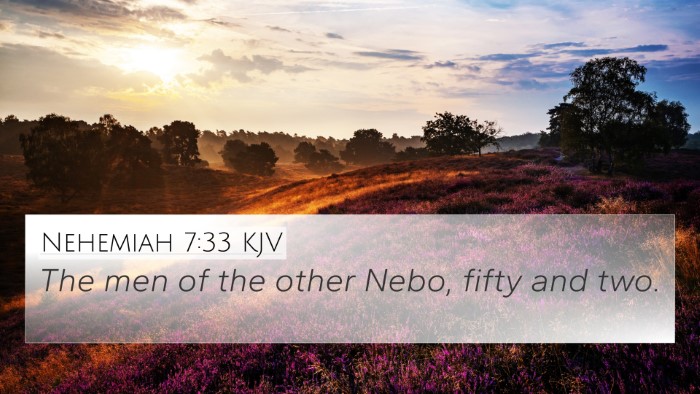Understanding Ezra 10:43
Verse: "Moreover, of the sons of Joiada the son of Jeshuah the high priest, there were taken to be married two of the daughters of Sanballat the Horonite; and his son Jehohanan had taken the daughter of Meshullam the son of Berechiah." (Ezra 10:43)
Summary: Ezra 10:43 highlights the challenges faced by the returning exiles regarding intermarriage with foreign people, which was contrary to the teachings of the Torah. The individuals mentioned underscore a significant issue where priests, who should be leading by example in maintaining holiness, are now partaking in practices that dilute their sacred responsibilities.
Commentary Insights
Matthew Henry
Matthew Henry elaborates that this verse showcases the ongoing struggle of Israel to remain faithful following their return to Jerusalem. The mention of Jeshuah's descendants marrying the daughters of Sanballat symbolizes the dangers of foreign alliances and mixing with idolaters, as it risks compromising spiritual integrity.
Albert Barnes
Albert Barnes remarks on the importance of maintaining proper lineage among the priests. He emphasizes that the involvement of the priestly line in such marriages not only violates their holy vows but also threatens the sanctity of their priestly roles. Furthermore, it reflects a lapse in community vigilance against the influences that can lead them away from God's commandments.
Adam Clarke
Adam Clarke provides an analysis that focuses on the broader implications of this intermarriage, relating it to the leadership's responsibility in setting an example. Clarke argues that the adoption of foreign practices and beliefs can lead to the corruption of biblical truth and dilutes the worship of Yahweh. He also notes that the issues of marriage and idolatry were perennial challenges for Israel, which can be traced throughout their history.
Cross-References and Thematic Connections
Understanding Ezra 10:43 deepens when we identify its connections with other biblical verses. The following verses relate closely, providing insights into the overarching themes of divine covenant, holiness, and the consequences of straying from God’s law:
- Deuteronomy 7:3-4: Warns against marrying foreign women to prevent leading Israelites into idolatry.
- Nehemiah 13:23-27: Nehemiah addresses the issue of intermarriage and its repercussions, similar to Ezra's concerns.
- 2 Corinthians 6:14: Paul advises against being unequally yoked with unbelievers, reflecting the NT continuation of this theme.
- Malachi 2:11: Speaks about marrying foreign women and the betrayal of God’s covenant.
- Exodus 34:16: Advises against taking daughters of foreign nations for sons, linking back to the necessity of maintaining covenant purity.
- Joshua 23:12-13: Warns Israel of the dangers of associating with the remaining nations and their gods.
- James 4:4: Commentary on friendship with the world equating to enmity with God, highlighting spiritual separation.
Thematic Analysis of Ezra 10:43
This verse serves as a critical point for understanding the theme of spiritual purity within God’s covenant community. It illustrates the necessity for vigilance in maintaining religious identity and integrity:
- Holiness Vs. Assimilation: The struggle to remain holy while surrounded by foreign influences.
- Leadership Responsibility: The expectation for leaders to uphold and reflect God’s standards.
- Consequences of Compromise: The inevitable decline in spiritual fidelity when engaging with contrary beliefs.
- Restoration and Repentance: Ezra’s narrative emphasizes the need for communal repentance and restoration to covenant fidelity.
Practical Applications
In studying Ezra 10:43, several practical lessons emerge that can be applied in contemporary contexts:
- Be Discerning: Cultivate discernment in personal relationships and alliances.
- Lead by Example: Encourage leaders in community settings to exemplify biblical principles.
- Uphold Identity: Strive to maintain a clear identity as followers of Christ in a pluralistic society.
- Embrace Community Accountability: Foster environments that encourage accountability toward spiritual standards.




